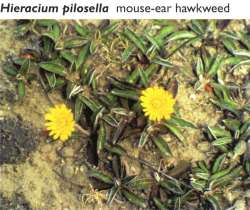|
 An
Illustrated Guide to An
Illustrated Guide to
Common Weeds
of New Zealand
Pilosella officinarum
(syn. Hieracium
pilosella)
mouse-ear
hawkweed
Family
ASTERACEAE
 Reproduced
from Reproduced
from
Common
Weeds of New Zealand
by Ian Popay, Paul Champion & Trevor James
ISBN 0 473 09760 5
by kind permission of the
New
Zealand Plant Protection Society
Publication or other use of images or descriptive
text on these pages is unauthorised unless written permission is
obtained from the authors and publisher.
Appropriate acknowledgement
of the publication Common Weeds of New Zealand must always
be given.
Available from Nationwide Book Distributors
Creeping, rosette-based,
mat-forming perennial, often in dense colonies that exclude all
other vegetation. Each flower stalk carries one large yellow composite
flower head. The leaves have long hairs on the upper surface, and
are downy white with star-shaped hairs on the undersides.
- Flowers
Lemon-yellow, about 3 cm in diameter, solitary on leafless stalks.
The florets often have a red stripe the on outer surface. Flowers
Oct-Feb.
- Fruit
Purplish-black achenes, about 2 mm by 0.5 mm, with off-white,
simple brittle pappus hairs 5-6 mm long in a single row.
- Leaves
Dense rosette leaves are 5-8 cm long, almost entire, bluish-green.
Leaves with scattered long hairs about 5 mm long on the upper
surface, white with dense star-shaped hairs on undersides.
- Stems
Slender, unbranched flower stalks 10-25 cm tall and slender, creeping,
hairy stolons spreading along the ground surface.
- Roots
Creeping underground rhizomes.
Habitat
High-country tussock
and dry pasture land, river flats and terraces, road-sides and
forest margins.
Distribution
Increasing in NI in
Rotorua, Volcanic Plateau, Lake Waikaremoana, Kaimanawa and Ruahine
Ranges and in Hawkes Bay. Common throughout SI and, except for
Nelson, abundant in upper Waitaki Valley. Originally from Europe,
north and central Asia.
Comments
A major weed of SI
High Country pastures. Can be controlled by pasture improvement.
Separated from other, similar species, by its large, solitary,
pale yellow flowers and dense star-shaped hairs on stolons and
undersides of leaves. Subject to Pest Plant Management Strategies
in one or more regions. Check with the regional council for details.
Derivation
of botanical name
Hieracium
from the Gr. name for hawk, since Pliny, the Roman naturalist
believed hawks ate the plant to strengthen their eyesight; pilosella
(Lat.) = with short soft hairs.
Web-notes:
Weed Links
On this site
Reproduced from Common Weeds
of New Zealand:
External Links
 Weedbusters
New Zealand Weedbusters
New Zealand
- Weedbusters is a weeds awareness and education programme that aims to
protect New Zealand's environment from the increasing weed problem.
- AgPest
- A free tool to assist farmers and agricultural professionals in decision-making regarding weed and pest identification, biology, impact and management.
 New Zealand Weeds Key New Zealand Weeds Key
- An interactive identification key to the weeds of New Zealand. Developed at Landcare Research.
New
Zealand Plant Conservation Network naturalised plants
- Search for information on more than 2500 naturalised and weedy plants.
 New
Zealand Plant Protection Society New
Zealand Plant Protection Society
- Their main objective: "To pool and exchange information on the biology
of weeds, invertebrate and vertebrate pests, pathogens and beneficial organisms
and methods for modifying their effects."
-
 Massey
University Weeds Database Massey
University Weeds Database- A site providing information about New Zealand weeds and weed control.
It has a series of pages showing pictures of New Zealand weeds, notes on
identification and control. It also provides information on a university
paper entitled Controlling Weeds.
-
-
More
Plant Profiles
|



 Reproduced
from
Reproduced
from


